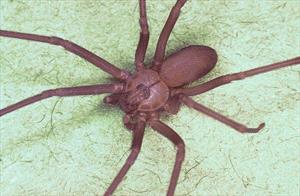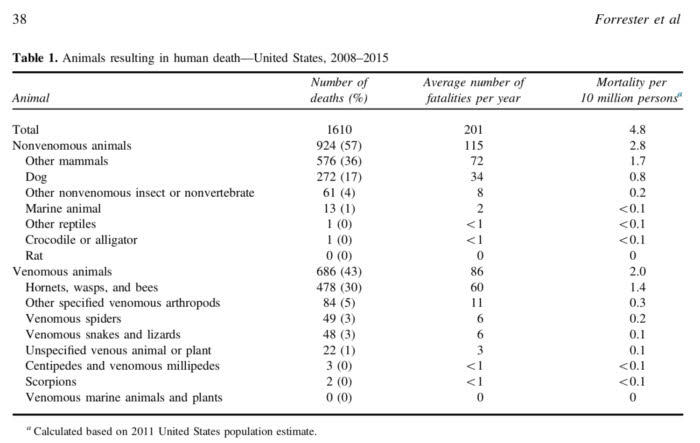
Quick question: What species do you think accounts for the most human deaths in the U.S.?
A recent paper in Wilderness & Environmental Medicine (Forrester et al, 2017. An update on fatalities due to venomous and nonvenomous animals in the United States, (2008-2015)) explored this topic, using a CDC database to study deaths that occurred between 2008 and 2015.
- 1610 deaths were reported, or about 200 per year. That’s a reasonably big number, but when you consider size of the population in the U.S., it’s low. That rate corresponds to 4.8 deaths per 10 million people per year.
- Most deaths were caused by non-venomous animals, something that shouldn’t be surprising considering venomous species are much less commonly encountered in most parts of the U.S. compared to non-venomous species.
- However, the number of venomous animal-associated deaths was still quite high, mainly from stinging insects (probably from allergic reactions).
- Dogs accounted for the most deaths, which also isn’t surprising given the large number of dogs in the U.S. Most pose little to no threat, but all it takes is a very small number of problematic dogs (and/or owners) for a noticable number of deaths to occur.
- Males accounted for 72% of deaths from animal encounters. Females only led in deaths caused by centipedes and venomous millipedes. I can explain why males might dominate some of the categories, but the female link to centipedes and millipedes eludes me. Probably, it’s just a function of small sample size, since only 3 people died from those: 2 females and 1 male.
- The highest mortality rate was in people over 65 years of age. Stinging insects accounted for much of that.
- Deaths from dog attacks were nearly four-fold higher in kids 4 years of age or younger.

The study provides some interesting information, but the dataset is probably far from complete in terms of all deaths associated with animals. It includes deaths from “bite, contact, attack or envenomation.” That doesn’t seem to include infection, and zoonotic infections certainly would add to the totals.
For example, the table indicates no deaths from rats. That might not sound strange, but it depends on how deaths are considered. I wouldn’t expect rat attacks to be a cause of death, but I do know of rat bite fever deaths during that time frame. Deaths from infections that came from an animal are still deaths and are important to consider.
Similarly, only one non-crocodile/alligator reptile-associated death was reported. However, Salmonella has killed more than that. Various other zoonotic infections are probably also missed. They’re fortunately still rare, but they do occur.
Regardless, some simple practices and precautions can reduce the risk of deaths from animals, whether by trauma or infection. There’s no way to completely eliminate risk, but reducing mortality and morbidity rates is a worthy (and attainable) goal.